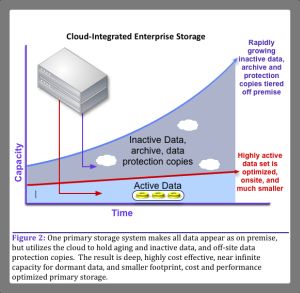In this article, we’ll discuss a new class of product that is only just coming center stage but looks poised to seriously alter how storage is done. This type of product is called cloud-integrated enterprise storage, or CES. CES is a new blend of cloud and primary storage that will create radical simplification in the practice of storage and drastically alter the on going costs of storing every piece of data a business ever creates. It almost sounds too good to be true, but after several years of watching this technology evolve and gain real world use, we have little doubt that cloud-integrated enterprise Storage is a force to be reckoned with. It is here, and it is here to stay.
The State Of Cloud Storage
Since Amazon first introduced S3 storage buckets, innovators have been looking at how to store more common types of data in the cloud. Storage buckets –- which contain storage objects accessed over the wire via a highly scalable and location agnostic HTTP protocol –- promise unique capabilities in three areas: 1) cost, 2) access and 3) scalability. In pure form, storage bucket technology is far from compatible with business storage. It requires a foreign storage protocol and great tolerance of latency and variable performance, and this doesn’t work for mainstream business applications.
Storage buckets have created opportunity among these challenges, and innovation has ensued. The earliest cloudy storage innovators looked to harness these storage buckets and sought obvious IT challenges that were easily matched to the cloud’s unique capabilities. On the surface this appears an easy task, but it has required serious innovation around connecting the traditional infrastructure to the cloud and making use of the cloud to enhance data and application access. This has led to a number of first-generation cloud based storage offerings, including special purpose applications, collaboration solutions, backup solutions, data archiving and even cloud-attached storage appliance that use temporary local storage to intermediate the latency and foreign storage protocols of the cloud to enable traditional storage access.
Cloud-Integrated Enterprise Storage
What has so far eluded the focus of most of these innovators is an approach that pairs the cloud with how a business stores the primary data behind the core applications within the data center. Such data poses a challenge, as it is the crown jewel of the business, and is surrounded with even more demanding requirements that are infinitely harder to address with incompatible cloud characteristics.
Cloud-integrated enterprise storage, or CES, is a new category of technology that will tackle the misalignment between cloud access characteristics and the demands of enterprise storage by delivering enterprise-class primary storage first. Then, deeply integrated cloud technology will make this storage uniquely capable, and it will reach far beyond simply adding capacity. Instead, the cloud will fundamentally enhance each and every storage feature, and extend storage capabilities and storage depth so that data can be stored once and for all.
While on the surface such storage may look like a simple attachment to the cloud (see Figure 1), don’t be fooled, it goes much further. CES solutions will go further with innovative technology that optimizes the placement of every stored data byte, and then use the offsite, access-from-anywhere, highly protected and near limitless scalability characteristics of the cloud to change transform the permanence and versatility of primary storage features.
Figure 1
In contrast to the earlier cloud-attached appliances and software, the onsite storage system will be fully authoritative for every stored byte of data, rather than acting purely as a cache or transmission device. That storage system will optimally place every byte of data and continuously optimize placement. This will keep highly active data on high-speed storage inside the enterprise walls (see Figure 2). But this far ranging auto-placement will create far more than just limitless capacity. Why? Because primary storage is the birthplace of nearly ever storage challenge, and well-integrated cloud storage could eradicate many of these challenges.
Figure 2






